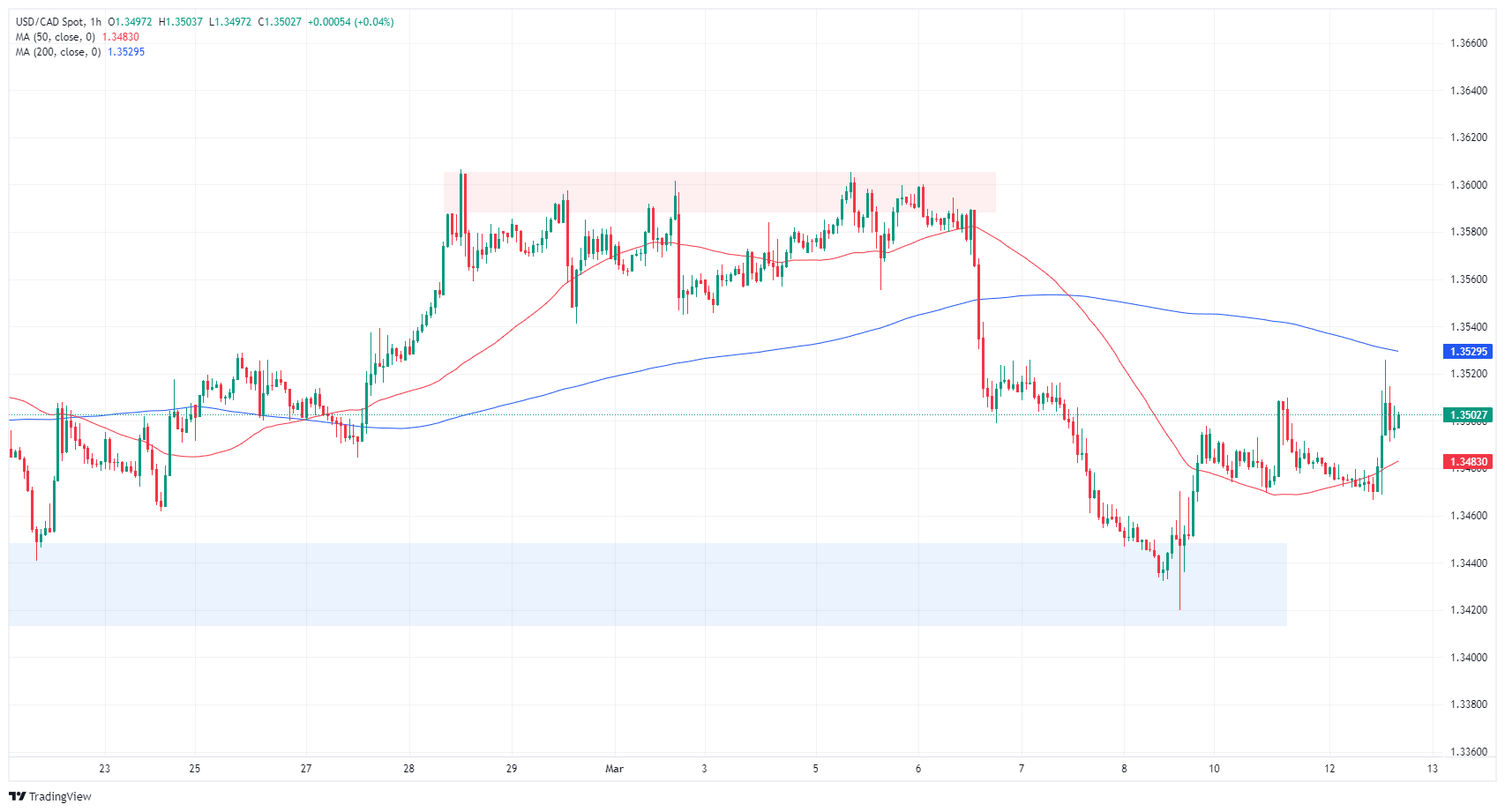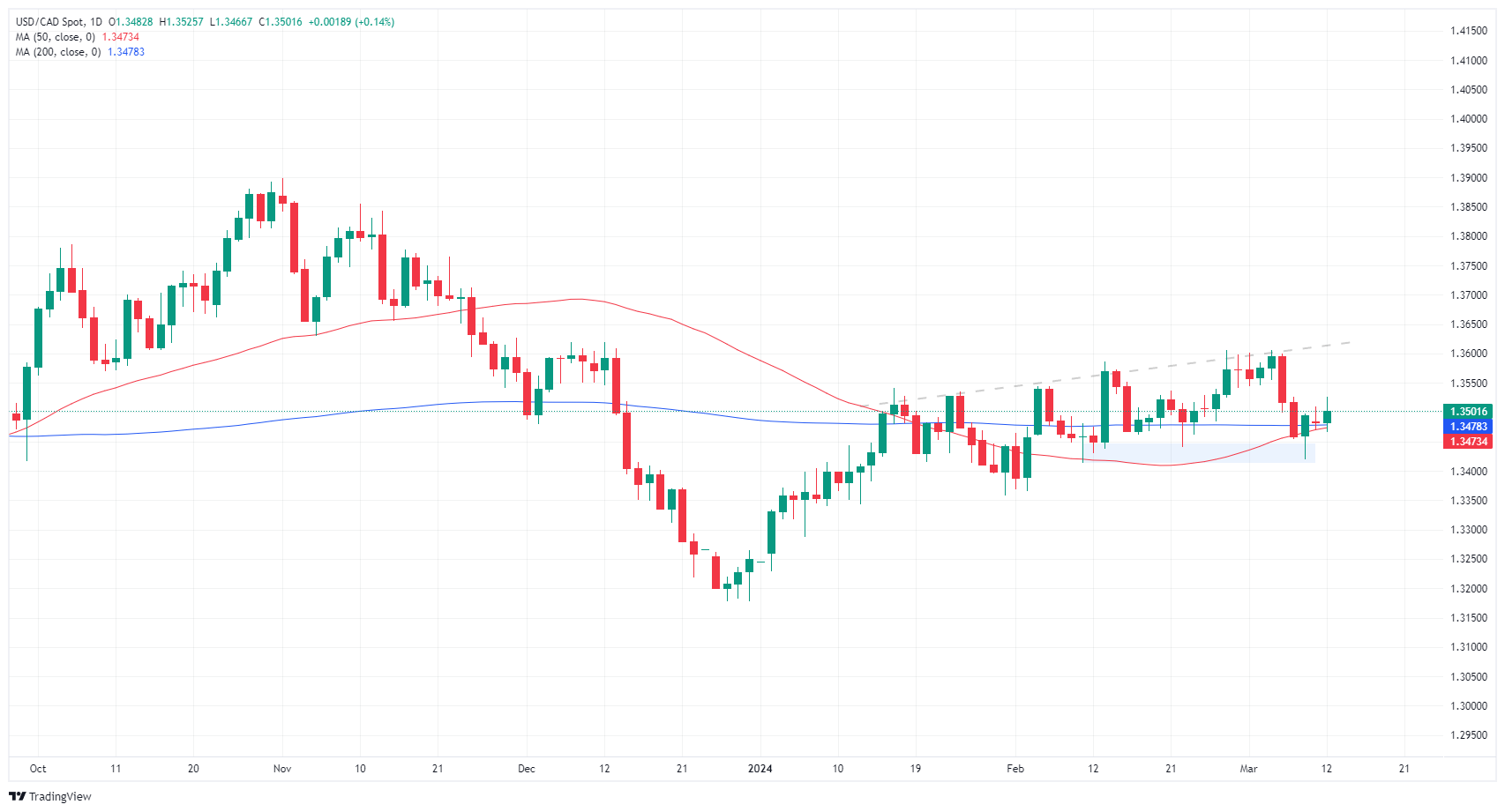- Phân tích
- Tin tức và các công cụ
- Tin tức thị trường
- Canadian Dollar rides rough chop against Greenback post-CPI inflation print
Canadian Dollar rides rough chop against Greenback post-CPI inflation print
- USD/CAD recovers to 1.3500 in choppy trading.
- Canada takes a back seat with strictly low-tier data on offer.
- US CPI inflation eased but less than expected.
The Canadian Dollar (CAD) was mixed on Tuesday, either holding flat or grabbing slim gains against some of its major currency peers, all while shedding points against the US Dollar (USD). Headline US Consumer Price Index (CPI) inflation came in higher than expected, but overall CPI inflation declined, helping to bolster investor rate cut bets from the Federal Reserve (Fed).
Canada only brings a smattering of low-tier economic data to the release schedule this week, leaving the Canadian Dollar exposed to broader market flows. Thursday brings Canadian Manufacturing Sales for January, and Friday will give an update on Canadian Housing Starts in February. Neither is expected to move the needle in a meaningful way.
Daily digest market movers: Uneven US CPI inflation print falls overall but less than hoped for
- US CPI headline inflation for the year ended February ticked up to 3.2% YoY versus the expected hold at 3.1%.
- Core US YoY CPI ticked down to 3.8% from the previous 3.9%, but still higher than the median market forecast of 3.7%.
- MoM CPI ticked higher to 0.4% as expected, slightly accelerating from the previous print of 0.3%.
- MoM Core CPI held steady at 0.4% versus the forecasted decline to 0.3%.
- Markets turn to Thursday’s US Producer Price Index (PPI) and Retail Sales figures for February.
- Core PPI in February is expected to ease to 1.9% from the previous 2.0%.
- MoM Retail Sales in February are forecast to rebound to 0.8% after the previous print of -0.8%.
- Friday will see the University of Michigan’s Consumer Sentiment Index for March, which is forecast to hold at 76.9.
Canadian Dollar price today
The table below shows the percentage change of Canadian Dollar (CAD) against listed major currencies today. Canadian Dollar was the weakest against the US Dollar.
| USD | EUR | GBP | CAD | AUD | JPY | NZD | CHF | |
| USD | 0.12% | 0.26% | 0.16% | 0.28% | 0.68% | 0.40% | 0.09% | |
| EUR | -0.12% | 0.14% | 0.04% | 0.15% | 0.54% | 0.27% | -0.03% | |
| GBP | -0.27% | -0.14% | -0.11% | -0.01% | 0.40% | 0.14% | -0.16% | |
| CAD | -0.16% | -0.04% | 0.11% | 0.10% | 0.50% | 0.23% | -0.03% | |
| AUD | -0.26% | -0.14% | 0.01% | -0.09% | 0.40% | 0.14% | -0.15% | |
| JPY | -0.68% | -0.54% | -0.40% | -0.51% | -0.43% | -0.27% | -0.56% | |
| NZD | -0.39% | -0.26% | -0.14% | -0.21% | -0.11% | 0.28% | -0.29% | |
| CHF | -0.10% | 0.04% | 0.17% | 0.06% | 0.13% | 0.55% | 0.29% |
The heat map shows percentage changes of major currencies against each other. The base currency is picked from the left column, while the quote currency is picked from the top row. For example, if you pick the Euro from the left column and move along the horizontal line to the Japanese Yen, the percentage change displayed in the box will represent EUR (base)/JPY (quote).
Technical analysis: USD/CAD back into familiar technical levels near 1.3500
On Tuesday, the Canadian Dollar (CAD) was down close to a fifth of a percent against the US Dollar, but it remained next to flat against the Euro (EUR) and the Swiss Franc (CHF). The Antipodeans and Japanese Yen (JPY) are broadly softer on the day, giving up ground against the CAD.
USD/CAD is back into the 1.3500 handle once again after choppy trading in the early Tuesday session. It bounced from 1.3470 and saw hard pushback from 1.3520. The pair is bound between supply and demand zones between 1.3450 and 1.3590.
A bullish turn in the USD/CAD will bounce bids off of the 200-day Simple Moving Average (SMA) at 1.3478, and the way is open for buyers to explore into the 1.3600 handle as a pattern of higher highs bakes into the chart paper. On the low side, failure to capture territory north of the 200-day SMA will see the pair dump back into early February low bids near 1.3360.
USD/CAD hourly chart
USD/CAD daily chart
Canadian Dollar FAQs
The key factors driving the Canadian Dollar (CAD) are the level of interest rates set by the Bank of Canada (BoC), the price of Oil, Canada’s largest export, the health of its economy, inflation and the Trade Balance, which is the difference between the value of Canada’s exports versus its imports. Other factors include market sentiment – whether investors are taking on more risky assets (risk-on) or seeking safe-havens (risk-off) – with risk-on being CAD-positive. As its largest trading partner, the health of the US economy is also a key factor influencing the Canadian Dollar.
The Bank of Canada (BoC) has a significant influence on the Canadian Dollar by setting the level of interest rates that banks can lend to one another. This influences the level of interest rates for everyone. The main goal of the BoC is to maintain inflation at 1-3% by adjusting interest rates up or down. Relatively higher interest rates tend to be positive for the CAD. The Bank of Canada can also use quantitative easing and tightening to influence credit conditions, with the former CAD-negative and the latter CAD-positive.
The price of Oil is a key factor impacting the value of the Canadian Dollar. Petroleum is Canada’s biggest export, so Oil price tends to have an immediate impact on the CAD value. Generally, if Oil price rises CAD also goes up, as aggregate demand for the currency increases. The opposite is the case if the price of Oil falls. Higher Oil prices also tend to result in a greater likelihood of a positive Trade Balance, which is also supportive of the CAD.
While inflation had always traditionally been thought of as a negative factor for a currency since it lowers the value of money, the opposite has actually been the case in modern times with the relaxation of cross-border capital controls. Higher inflation tends to lead central banks to put up interest rates which attracts more capital inflows from global investors seeking a lucrative place to keep their money. This increases demand for the local currency, which in Canada’s case is the Canadian Dollar.
Macroeconomic data releases gauge the health of the economy and can have an impact on the Canadian Dollar. Indicators such as GDP, Manufacturing and Services PMIs, employment, and consumer sentiment surveys can all influence the direction of the CAD. A strong economy is good for the Canadian Dollar. Not only does it attract more foreign investment but it may encourage the Bank of Canada to put up interest rates, leading to a stronger currency. If economic data is weak, however, the CAD is likely to fall.
© 2000-2024. Bản quyền Teletrade.
Trang web này được quản lý bởi Teletrade D.J. LLC 2351 LLC 2022 (Euro House, Richmond Hill Road, Kingstown, VC0100, St. Vincent and the Grenadines).
Thông tin trên trang web không phải là cơ sở để đưa ra quyết định đầu tư và chỉ được cung cấp cho mục đích làm quen.
Giao dịch trên thị trường tài chính (đặc biệt là giao dịch sử dụng các công cụ biên) mở ra những cơ hội lớn và tạo điều kiện cho các nhà đầu tư sẵn sàng mạo hiểm để thu lợi nhuận, tuy nhiên nó mang trong mình nguy cơ rủi ro khá cao. Chính vì vậy trước khi tiến hành giao dịch cần phải xem xét mọi mặt vấn đề chấp nhận tiến hành giao dịch cụ thể xét theo quan điểm của nguồn lực tài chính sẵn có và mức độ am hiểu thị trường tài chính.
Sử dụng thông tin: sử dụng toàn bộ hay riêng biệt các dữ liệu trên trang web của công ty TeleTrade như một nguồn cung cấp thông tin nhất định. Việc sử dụng tư liệu từ trang web cần kèm theo liên kết đến trang teletrade.vn. Việc tự động thu thập số liệu cũng như thông tin từ trang web TeleTrade đều không được phép.
Xin vui lòng liên hệ với pr@teletrade.global nếu có câu hỏi.















